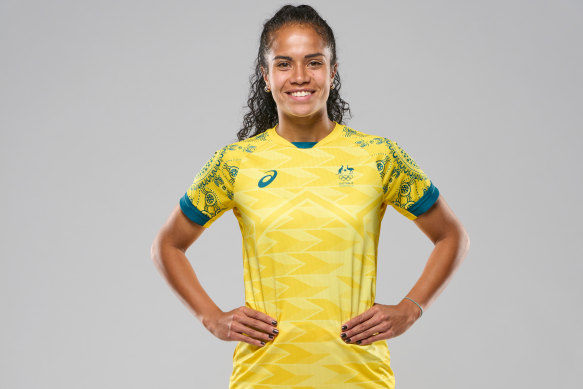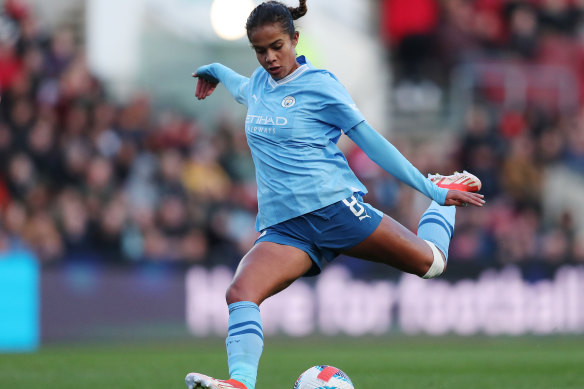For her coach, Mary Fowler is an unsolved riddle. And she may be the Matildas’ most important player
By Emma Kemp and Vince Rugari
Mary Fowler spent the early part of her Manchester City career napping. Not caught napping in a took-her-eye-off-the-ball sort of way, but literally eyes closed and head on the pillow. Fowler, who had moved from the southern France sunshine of Montpellier, took a little while to acclimatise to the northern England climate.
“When it’s dark outside at 3.30pm and it’s raining, it’s just perfect napping weather,” she says. “So I was literally coming home [from training] every day and going to sleep, and then I’d wake up at 6pm and it wasn’t productive at all.
“It is a bit challenging at times, but since I’ve gotten that a bit more under control I feel a bit more like I’m living. Now after training I’ll usually just stay out, go to cafes, and then go home and make dinner. That’s been a big growth experience in itself, and one that probably has also gone hand in hand with my performances on the field. Because as I got more used to spending time on my own again, I’ve ended up having better performances.”
Of course there are other factors at play beyond the decision to either sleep or not sleep, not least the process of carving out her place in a stacked side that finished second only to Chelsea last Women’s Super League season. Even after the World Cup that made her so famous she was immortalised as Barbie, she continued the “two steps forward, one step back” journey in Manchester.
“After the World Cup I was on a bit of a high, but probably didn’t realise how much of a mental break I needed to be able to sustain that kind of performance for the rest of the season,” she says. “Being on the bench coincided with that feeling of me being a bit mentally tired.

Mary Fowler could be the Matildas’ most important player in Paris.
“But overall, I think it was quite a positive season, getting to play in the back end and just feeling so much more refreshed and being like ‘This is good. This is how I play. I’m confident again.’”
But the two-year slow burn is now reaping rewards, and it could not come at a more convenient time for a national team on the eve of an Olympics campaign with a number of high-profile attacking headaches.
With no Sam Kerr, and Caitlin Foord under a worrying injury cloud, Fowler might now well be Australia’s most important player. The challenge – as is the case with many ethereal shape-shifters who require freedom to make their magic – will be how to get the best out of the 21-year-old.
Fowler has the capacity to turn a game on its head with a single pass or run, but she is also a bit of an enigma. A code coaches must crack to reap the rewards. It took City manager Gareth Taylor a full season to get there.
Before the 2023 World Cup, the club had treated her as an attacking midfielder who could play between the lines. Then, after 12 months of improving but never quite breaking into the team, Taylor moved her to the wing.
‘She can go on a streak, Mary, where you just go “wow”, and that’s really hard to do when you’ve got your back to goal.’
Manchester City manager Gareth Taylor
“It just felt that she needed to see the game a little bit more, and she could do that a lot more playing in the wide areas,” says Taylor. “She then has the ability then to see so much, and we were able to probably get the ball more often to her.
“I always said last season to the players, ‘As much as you can, get the ball to Mary.’ Why? Because she causes damage.”
Within City’s highly structured set-up, Taylor now firmly believes “that’s where she’s at her best”.
“I remember seeing her at the [Tokyo 2020] Olympics when she broke onto the scene, and she was predominantly playing behind the striker, or actually as the striker,” he says. “I played as a striker, and I think it’s one of the toughest positions because you’ve constantly got your back to goal.

Manchester City and Matildas star Mary Fowler.Credit: Getty Images
“With certain players, but particularly Mary, they need to be more open, their shoulders need to be facing the goal, because for me she’s one of the best finishers we have. She can go on a streak, Mary, where you just go ‘wow’, and that’s really hard to do when you’ve got your back to goal.”
But then Taylor qualifies what he has just said by praising Fowler’s ability to shift from left to right and use both feet. And adds that she can be the best player in every single match but sometimes “we probably don’t see the best side of her”.
It is little wonder he and his Matildas counterpart Tony Gustavsson have “picked each other’s brains” to try to solve the riddle. A couple of months ago, Gustavsson freely admitted he had not yet got to the bottom of it while also catering for the talents of Kerr (one of the world’s best strikers) and Foord (who thrives on the left wing for both club and country).
But if Foord is not fit in time for Friday morning’s opening group fixture against Germany, Fowler could find herself as the figurative centrepiece of the XI.
“I love it so much on the wing [for City] because that’s probably the position with the most freedom on the field, and I’m a very non-structured type of player,” Fowler says. “So I think it works for me, and I’d like to say it helps the team.
“At national team we see a different way of playing, and I think we just try to play in a way that suits the most amount of players. So sometimes that means getting a different quality out of me. At the end of the day, I don’t really mind where I play, I’m just happy to be on the field and trying to help the team out.”
Fowler has not only become a key component of the team but also the face of the Matildas, and arguably Australia’s entire Olympic team. Look for any form of pre-Games promotional material, and she’ll be there or thereabouts; few others, you’d imagine, will be asked to pose for as many photos or sign as many signatures in the athletes’ village as she will.
Taylor got a sense of how big of a deal Fowler had become in her home country, and her status as a national “pin-up girl”, when he visited for the World Cup. Now that she’s dating an NRL player, she has broken through to a whole new level of celebrity. After the Olympics, she will return to Australia with Manchester City for a pre-season tournament in Perth with West Ham United, Leicester City and Paris Saint-Germain – a venture which seems to be leaning, to a large degree, on her own personal star power.
It must be a cloistering experience, to have all that pressure on your shoulders and all those media outlets prying into your private life, but she brushes it aside. “People have bigger problems than some of that stuff, so you’ve just got to laugh about it and move on, really,” she says.
Fowler is not quite a big deal in England just yet, but that’s coming.
“I don’t think people have really seen probably that kind of big ‘wow’ player at this moment in time,” Taylor says. “But I certainly think people are starting to sit up and pay attention now.”
By Taylor’s estimation, the only thing that can stop Fowler from becoming the best player in the world is Fowler herself.
“I think this season coming, we’re expecting really big things of her, because she’s in that right moment now,” he says. “She knows the club, she knows me, she knows the players, she knows the league. This is where we’re going to see her really, really set it off.”
News, results and expert analysis from the Olympics sent daily throughout the Games. Sign up for our Sport newsletter.